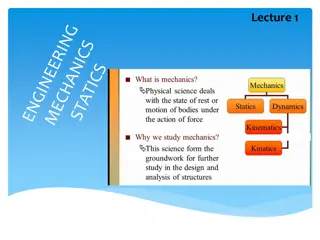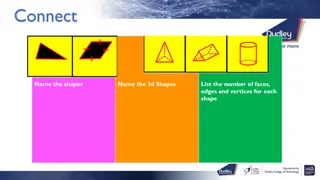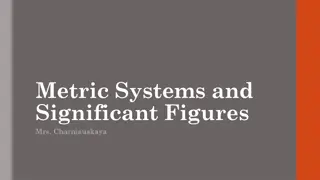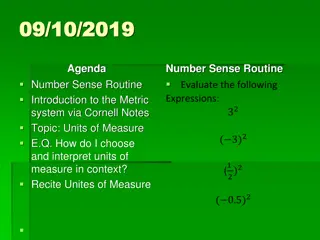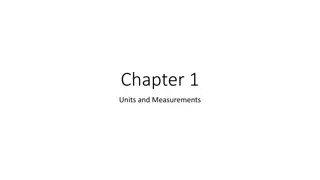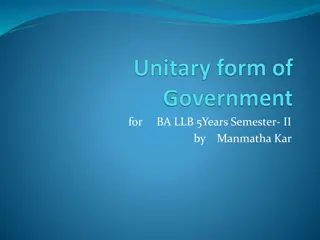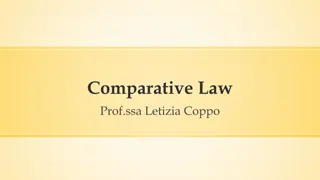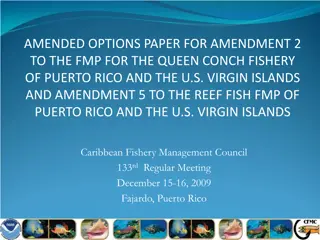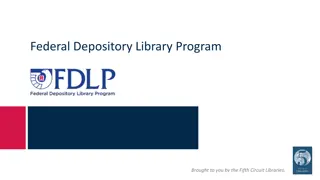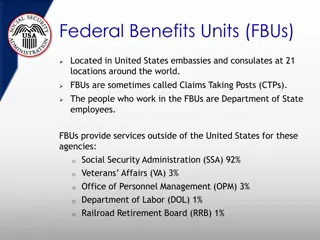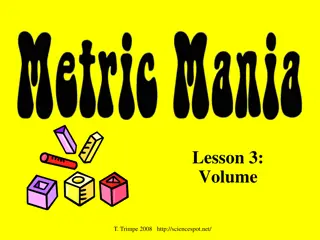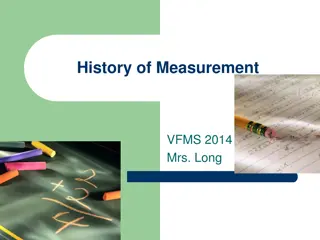Creation of Constituent Units in Federal Systems
Within federal systems, defining constituent units can be a politically charged process, impacting the operationalization of federations. This presentation explores the challenges and decision-making criteria involved in creating and adjusting constituent units during constitutional transitions to federalism, drawing on global experiences of establishing political maps.
Download Presentation

Please find below an Image/Link to download the presentation.
The content on the website is provided AS IS for your information and personal use only. It may not be sold, licensed, or shared on other websites without obtaining consent from the author.If you encounter any issues during the download, it is possible that the publisher has removed the file from their server.
You are allowed to download the files provided on this website for personal or commercial use, subject to the condition that they are used lawfully. All files are the property of their respective owners.
The content on the website is provided AS IS for your information and personal use only. It may not be sold, licensed, or shared on other websites without obtaining consent from the author.
E N D
Presentation Transcript
Creation of Constituent Units in Federal Systems Presentation for the United Nations Mission in Somalia George Anderson April 2014
The Issue Federal and devolved systems of government are based on a political delimitation of a country s territory into states, provinces or regions (constituent units: CUs) When previously unitary countries federalize, delimiting the new CUs can be politically controversial Even long established federations can find that they may need to create new CUs or adjust boundaries on occasion In several countries that have recently federalized or devolved, or are planning to, the issue of defining CUs has been a significant issue. In some cases it is still not resolved. This contrasts with experience in most of the long established federations where the definition of the CUs was not a major issue.
Constituent Unit Creation and Constitutional Transitions to Federalism During a constitutional transition to federalism, decisions must be taken about: The timing for determining CUs The criteria for establishing CUs The decision-making process re CUs during the transitional period Provisions about possible future changes re CUs in the constitution. This presentation reviews these questions in turn, drawing on the experience of countries that have undertaken a major redrawing of their political map.
Timing for Determining Constitutent Units: Varied Recent Experiences Bosnia-Herzevogina, Ethiopia, South Africa, and Spain wrote new political maps as part of their constitutional transition to federalism India and Nigeria undertook major revisions to their maps some years after their transition to federalism Iraq and Somalia have constitutional procedures for determining their new federal maps, but have not completed the process. Libya, Myanmar, Nepal and Yemen are all currently engaged in political transitions in which the new political map will be a major issue. Germany, India, Russia, and Switzerland have merged CUs or created new ones within established federal maps long after approving their constitution. Most other federations have explicit constitutional rules that establish procedures for adding or consolidating CUs or for changing boundaries.
Timing : Considerations A federation cannot become fully operational until the constituent units are defined so the ideal timing for defining them is before the constitution takes effect, but this may not be possible. India operated on the basis of temporary states for a few years and then had a major process to redraw the whole federal map. The constitution accommodated this with a flexible amending formula. Iraq had only one region defined when the constitution took effect, so the regime is very asymmetric and unresolved. Their constitution has rules for creating new regions, but the process has been blocked. If the CUs are not defined when the constitution takes effect, there could be a deadline for completing the process. Creating new CUs after the federal map is drawn is relatively unusual. Stability is an advantage, but there may be a need for some flexibility. Boundary adjustments between CUs are easier to deal with than the creation of new CUs
Approaches to Major Redrawing of a Political Map Some countries need to write a new political map as they federalize, but their contexts vary and this affects their choice of approach The issue may be potentially very divisive politically (especially if there are highly distinct ethnic, linguistic or religious identities). Or it may have low salience. Existing administrative or other sub-national unit (or their boundaries) may provide a starting point . Or it may be necessary to draw entirely new boundaries. The country may be democratic or dominated by a ruling elite (military or post-revolutionary). Main alternatives approaches to determining CUs: Centrally determined, weakly consultative Centrally determined, strongly consultative Regional decision within central criteria Arbitration
Centrally determined, weakly consultative approaches Cases of strong central governments and under-developed democracy (Ethiopia after civil war; Nigeria under Generals). Decisions are very discretionary, though various criteria may apply. In Ethiopia main criterion was self-determination for nations and nationalities, but given number of ethnicities only major ones were made states. In South, many nations put into one state. Administrative effectiveness a consideration. Process highly centralized with decisions made within coalition of rebel groups that won civil war. In Nigeria Generals redrew federal map several times. First major change broke four-state model which pitted major groups against one another. Later changes responded to political pressures, but smaller minorities felt short-changed. Generals did have advisory groups which consulted population, but only partly implemented their recommendations.
Centrally determined, strongly consultative processes: India India undertook a major state reorganization a few years after independence. A non-partisan commission of three eminent persons conducted extensive hearings and received 1000s of submissions. The main criterion for state delimitation was linguistic, but the commission emphasized the need for a balanced approach, including factors such as administrative effectiveness. It recommended 14 states, some of which were bilingual. Parliament adopted its recommendations with minor changes. India subsequently created a further 15 states, always after extensive public debate and almost always with the consent of any state losing territory. However, there are still several active demands for new states, which is not surprising given the huge size of many states.
Centrally determined, strongly consultative processes: South Africa A Multi-Party Negotiating Forum prepared an interim constitution in 1993- 94. The MPNF named a 15-member multiparty commission to recommend new provinces; the commission then named a technical committee to prepare a proposal. There were hearings and public submissions. The whole process took six months. There were four broad criteria (economic, institutional, geographic, socio- cultural), with a deliberate policy of balance. The commission largely accepted the committee s report (one major change). The MPNF largely accepted the commission s report, but requested another round of hearings on some issues. The eventual report was agreed by 13 of 15 commissioners and essentially adopted by the MPNF. Some regional populations wanted to be put in another province, but these issues were postponed. The new provinces were defined in the constitution and approved by the constituent assembly. There have been four boundary adjustments affecting seven provinces since the constitution was approved.
Regional Decision within Central Criteria: Spain Spain had 50 administrative provinces but wanted to have fewer autonomous communities (ACs) as part of devolution in the 1970s Parliament s criteria for ACs were: bordering provinces sharing historic, cultural and economic characteristics; insular provinces; provinces that had historic regional status. Elected municipal officials in each province could then decide by a 2/3 vote accounting for 50% of a provinces population. They could also hold a referendum. If they failed to decide within 6 months, they could not have devolution for another 5 years. Parliament then verified their choice. The 50 provinces merged into 17 ACs.
Regional Decision Subject Only to Procedural Rules: Iraq Federal Iraq made a procedure for governorates to decide about becoming regions, but these rules do not include criteria for becoming a region. Any governorate (except Baghdad) or group of governorates may become a region. 2/3 of the council members of each governorate intending to form a region or 1/10 of the voters can initiate a referendum (whose procedures were to be initiated by law). Single governorates or any number together may form a region. There is no provision for changing boundaries. The process is in suspense, with only Kurdistan being a region. One issue was concern about a super region of many governorates in the south. The Somali model is similar in being essentially procedural (except for requiring at least 2 regions to form a member state), but it does provide for the number and boundaries of member states to be determined by the House of the People, based on recommendations of a national commission.
Arbitration: Bosnia-Herzegovina The federation emerged from intense negotiations after civil war. The presidents of Croatia and Serbia were key actors at the table and the Americans managed the negotiations. The definition of the new units largely reflected facts- on-the-ground, following mass displacements of people and ethnic cleansing. The peace agreement provided for arbitration of the boundary through one district (Brcko). After several years, and serious differences, the arbitrator imposed the creation of a new district which assumed the powers of the two entities that had divided it. Thus the alternative rejec
Approaches to a Major Redrawing of a Political Map Compared The highly centralized, weakly consultative approaches operated in exceptional circumstances and environments of controlled politics. They were not high on legitimacy. The more consultative centralized processes, guided by criteria, worked in environments where it was necessary to draw entirely new boundaries. Both the Indian and South African models had commissions that led the process, held hearings and did serious technical work. The Indian commission was non-partisan, while the South African one was partisan but even so it managed to have a technical working group that was effective. In neither case did the affected populations get to vote on the issue of their new CU. The Spanish process provided some criteria, but within those permitted local politicians to play the major role. To work, it required choices to be limited to combinations of provinces, not their division. Some provinces held referendums which enhanced legitimacy. The deadline was effective. The abortive Iraqi model was weakened by the lack of criteria about forming regions. The Somali model will need to clarify the respective roles of local decision-makers and those at the centre. Arbitration is a non-political approach that should only be used in extreme cases. But there may be instances where it, or mediation, can help resolve intractable problems.
Criteria for the Creation of New Constituent Units Criteria play different roles depending on the approach to defining CUs when a new political map is being drawn: usually important in centrally determined processes and they can be both explicit and implicit: the more criteria there are, the more the issue of balancing them arises limited or even non-existent in regional decision-making processes, e.g. non-existent in Iraq,very limited in Spain. There is a wide variety of criteria that have been invoked: economic, geographic and past boundaries, socio-cultural, political geometry , public opinion. As well, partisan considerations have sometimes been important, if not explicit. With multiple criteria, there is always a question of balance and their relative importance. Such criteria can also be invoked for incremental state creation.
Criteria Reviewed Economic: Governmental efficiency and effectiveness, including human and fiscal capacity, existing governmental infrastructure and its possible rationalization, service to the public. Financial costs (which may impose a minimum populatio and limit the number of CUs). Economic resources and development: There may be an attempt to favour natural economic regions and regions with diversity in their economy. Natural resources can a consideration in avoiding CUs that are very poor. However, fiscal transfers can address inequities associated with resource wealth. Geographic and past boundaries: rivers, mountains and other natural features can be important, along with established patterns of communication, transport and physical infrastructure. Past boundaries of administrative or political units (even historic boundaries) can be important and often serve at least in part for new boundaries. In the regional decision models for CU creation existing units can be the basic building block. The absence of past boundaries can make federalizing more difficult Socio-cultural: Ethnic, religious, linguistic, national . Often politically powerful and sensitive. Socio-cultural communities are rarely concentrated in one territory and most territories have some mix of populations.
Criteria Reviewed: 2 Socio-cultural (cont d): Creation of CUs on a socio- cultural basis raises issues about minorities inside and outside the CU. Also questions re ethnic vs. territorial federalism: do minorities have full rights (e.g. government employment) of majority? Deeply divided societies may combine regional CUs with group power-sharing (consociationalism) at the centre. Political geometry : Number and relative sizes of CUs affect federations dynamics. Avoid too few or too many CUs. Issue of CU status for separatist regions (Yemen). Balance of number of CUs for certain groups (Nigeria) or types of states (US pre-civil war) Public Opinion: Critical when regions vote on CU creation, but also important when consultations are engaged. Political parties may favour CU creation to win votes or weaken opposition parties.
Incremental CU Creation Once established, federations rarely establish new CUs out of existing ones (though settler federations do create CUs out of territories) However, constitution normally establish procedures for creating new CUs and revising boundaries. Especially important when unresolved issues re CU numbers and borders. Rules can have low threshold (e.g. simple majority in national legislature) or very high threshold (e.g. onerous rules for initiating referendum and then special majority needed for approving results). Choice of approach may reflect need to accommodate (India) or resist (Nigeria) new CU creation. Two broad approaches: Legislative based Referendum based
Incremental CU Creation: 2 Legislative based: Decision to create CU or change boundaries can be assigned: To national legislature alone (India; Australia for state created out of a federal territory) To national legislature plus affected CU or CUs (USA) To national legislature plus affected CU or CUs and some majority of all Cus (Canada) Referendum based: These may specify who can initiate referendum, what vote needed by whom, and role of national and other legislatures to ratify (or not) result of referendum: Right of initiative may be with some group of elected representatives (Switzerland) and/or by petition from a specified number of citizens in the affected area (Germany, Iraq) Referendum may be in an existing administrative or political unit(s) (Iraq) or in any area deemed to be a potential CU (Switzerland). CU referendum result may still need ratification by national referendum (Switzerland) or votes in national parliament plus legislatures of affected CUs and potentially of all CUs (with special majority.
Some Conclusions and Possible Lessons Countries that must draw a new political map face special challenges as part of federalizing: Can be especially difficult when there are strong demands for ethnic devolution, but borders are contested. The choice of process for creating CUs will reflect the local context: When existing administrative or political units are to be the basis for establishing new CUs (through combination or continuation), it is possible to provide for regional decision-making by locally elected officials or referendum When CUs are to be drawn using new boundaries, there needs to be a centralized decision- making system (which may involve extensive consultations) and normally some criteria for determining CUs should be set out Advisory commissions can be helpful, especially in conducting consultations and doing technical analysis. The commissions should be politically neutral or balanced, with strong technical capacity. When CU creation is politically very fraught, e,g, around identity groups, there are ways to lower the risk of conflict: New CUs might be created using criteria beyond just language or ethnicity Protections can be provided for minorities within the new CUs Fiscal arrangements can limit disparities between CUs Ethnic names for CUs, especially when they have significant minorities, can be avoided There should not be automatic procedures for revising boundaries based on demographic shifts.
Conclusions (contd) It is possible, but sub-optimal to delay CU determination when approving a federal constitution: A country can delay implementation of key federal features or operate temporarily using existing units. Constitutions should specify rules for incremental CU creation or boundary modification: Key issues include whether there should the rules on initiative, who decides (legislatures and/or referendums) and decision- rules, including how high is the threshold. The choice of threshold will depend on whether new CU creation is to be facilitated or discouraged.



